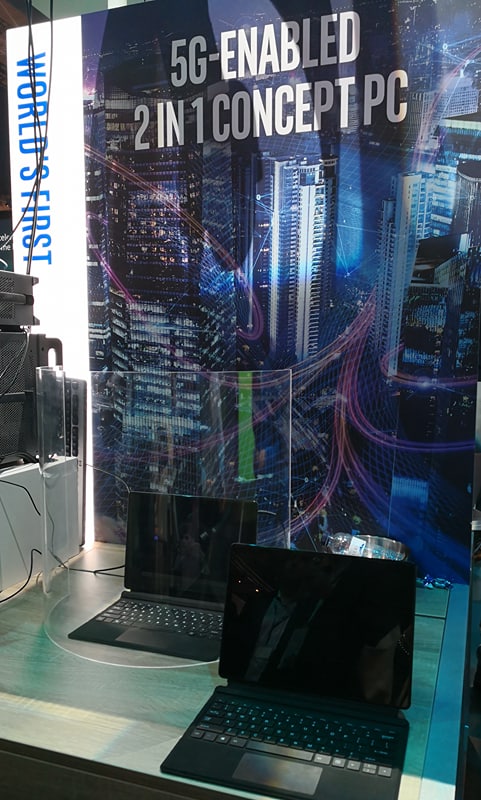Intel at MWC: How 5G will change the PC

Intel's 5G-connected PC prototype
Intel has told ZDNet that 5G-connected PCs will require a complete re-engineering of current 2-in-1s, with the first silicon due at the end of this year, samples at the beginning of next year, and devices in the second half of 2019.
MWC 2022
Speaking to ZDNet in an interview during Mobile World Congress (MWC) in Barcelona, Intel GM of 5G Advanced Technologies Rob Topol said Intel's 5G-connected PC prototype is the only product at MWC "that actually has a real 5G modem in it".
"We developed this chip and that prototype, we're already working on the form factor prototypes now beyond that 2-in-1," he told ZDNet.
The current chipset sitting inside the prototype is pre-5G New Radio (NR) standardisation, because Intel has been developing it over the past year; however, the main focus is to begin learning how to build the new wave of PCs and tablets, he explained.
"We wanted to start to experiment with form factors and learn where should we put the antennas. Putting a modem that can support 5Gbps changes even the way that you do thermals and heat transfer inside," he said.
"It doesn't look like a normal tablet or 2-in-1 inside. It really required new engineering, and so those learnings now help us translate them into -- we announced the partnerships with HP, Lenovo, Dell, Microsoft -- to take those learnings and co-engineer in the laptop form factor, as well as using that for tablets and others."
According to Topol, Intel has also decided to engineer a multi-mode chipset wherein it supports 2G through to 5G connectivity, as well as standalone and non-standalone 5G standards.
"So this is an all-in-one, every capability loaded into this design," Topol told ZDNet.
"We could have done earlier; we made a conscious decision to build with standards fully compliant, and make it multi-mode ... we'd rather have an optimised design when we expect scale to happen."
Topol said Intel's 5G interoperability trials with Huawei this week during MWC have also been fully compliant with 5G specifications, emphasising the importance of making sure radio heads, base stations, protocols, carrier spacing, channel coding, and modulation are all compliant and interworking.
Read also: Top 5G announcements from MWC 2018
"We didn't just go out and put press releases in NR. We're showing that it works between us and another partner," he said, adding that such trials build the "recipe" that Huawei can then take to carriers who build it out, while Intel takes the recipe to OEMs and ODMs.
"It allows both tracks to start the monetisation, the commercialisation ... we can do very quick interoperability, you're seeing form factors that others don't have yet, and it's all feeding into a commercial roadmap."
With Australia's dominant carrier Telstra earlier this week announcing that it will be working on 4G and 5G integration trials with Intel, Topol said the details are still being decided.
"We have planned trials with Telstra this year, we're working through the details of the types of use cases they want to demonstrate, but we do have an SOW [statement of work] we've signed with them," he told ZDNet.
"But yes, they are a planned trial partner and we're pretty excited about it."
Topol also gave ZDNet an update on Intel's wide-scale 5G trial during the PyeongChang Winter Olympic Games this month, and spoke about what the Tokyo 2020 Olympics partnership with NTT DoCoMo will bring.
"PyeongChang went very well. The goal was to show what 5G can do initially as a technology; secondly was to show how far we can take the scale and complexity and really test ourselves; and third was to test a few new use cases," Topol said.
"From a technology standpoint, we did work with KT, with Ericsson, with Nokia ... that's not simple. It means that we've all found ways for our equipment to interoperate and support the 5G interface."
Towards 2020, Topol said the main difference will be that while Intel trialled virtual reality (VR), 5G, artificial intelligence (AI), and drones as separate use cases and deployments during PyeongChang, these will start to converge in Tokyo.
"What you'll see towards Tokyo is how we feel a lot of those are going to converge, especially AI. As an Olympic sponsor, we own the category of artificial intelligence ... as you look towards 2020, you're going to see more of a convergence of AI, 5G, and some other technologies," he explained.
"We have some great plans with artificial intelligence to start using that for what we call predictive analytics, so being more predictive of what's happening in the Olympics, in the sports, with the athletes, making it more fun for people to know what might happen."
The Tokyo project will also see Intel utilise automation and sensors across cars, streetlamps, and other infrastructure in partnership with Tokyo City and NTT in order to form a smart Olympic city.
Disclosure: Corinne Reichert travelled to MWC 2018 in Barcelona as a guest of Huawei
MWC 2018 Coverage
- Huawei Australia CEO pushing more government 5G discussions
- Asus announces ZenFone 5 family: Apple iPhone X clones running Android priced at half the cost of the iPhone
- Sprint CTO at MWC: We have the best 5G spectrum
- MWC 2018: T-Mobile announces 5G for 30 cities
- Top 5G announcements from MWC 2018
- Telstra CEO at MWC: 5G race more than a flag in the ground
- MWC 2018: Cisco launches new Jasper Control Center for NB-IoT (TechRepublic)
- First Android Go phones unveiled at MWC 2018 (TechRepublic)
- Mobile device computing policy (Tech Pro Research)
